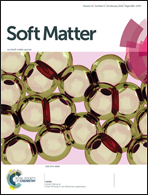Polyelectrolyte multilayers under compression: concurrent osmotic stress and colloidal probe atomic force microscopy†
Abstract
Colloidal interactions have been characterised using both osmotic stress and surface forces. Here these methods are employed concurrently to measure the interaction forces of polyelectrolyte multilayers that when cross-linked form a dextran impermeable membrane. The force data, corrected for the thickness of the polyelectrolyte multilayer film, has been expressed as pressure versus separation enabling the interaction from osmotic stress measurements to be compared to the measured interaction from the colloid probe technique. The combined technique is valuable in evaluating the interaction forces associated with compression of polymer films at different rates and over a wide range of pressure and demonstrates features that are not revealed when just one technique is employed. The combination of the techniques allows both attractive forces and strongly repulsive forces to be measured and shows that the measured repulsion is greater in the force data than in the osmotic data. This is due to insufficient equilibration time in the AFM measurements, even at the slowest approach rates available, indicating that AFM force measurements between polyelectrolytes will always contain a dynamic component. That is we demonstrate that colloid probe measurements between polymer surfaces overestimate the equilibrium repulsive interaction due to the rate at which the measurement is performed.



 Please wait while we load your content...
Please wait while we load your content...